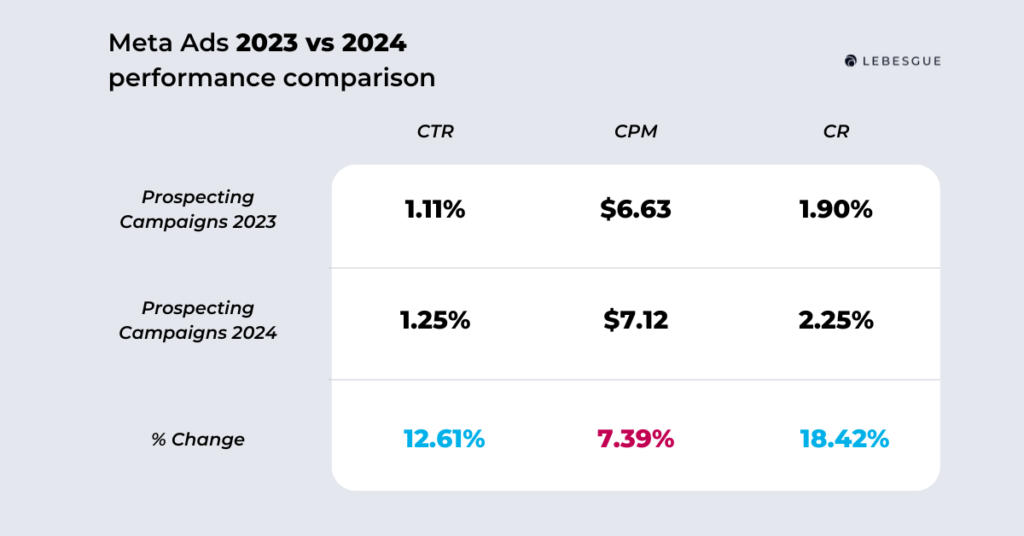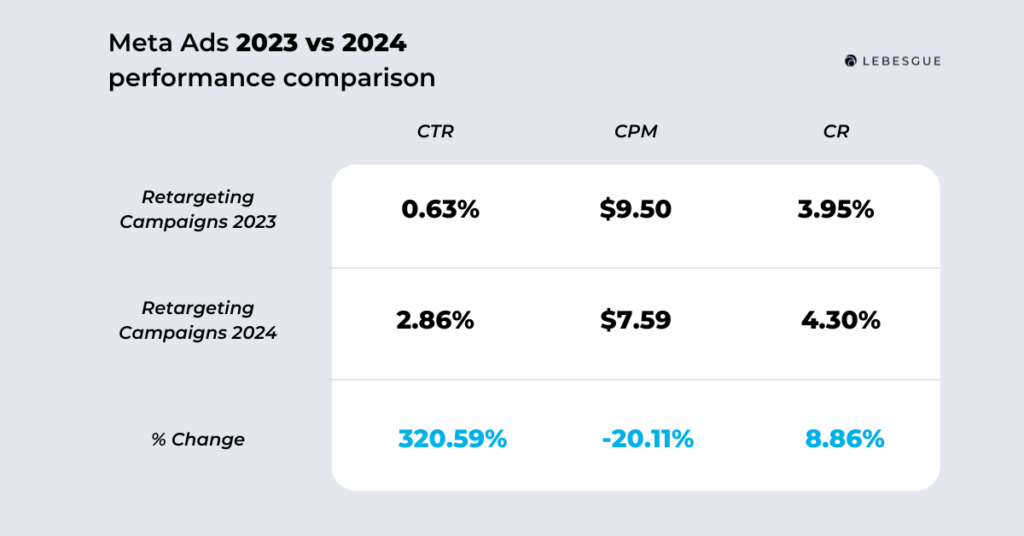Since February 2024, there has been a lot of talk about Facebook’s performance, particularly regarding the effectiveness of its ads for businesses. But is this talk justified? What exactly changed with Meta ads performance at the start of 2024, and what factors could be affecting their performance?
Let’s take a closer look at Facebook’s performance metrics to understand what’s really going on.
Meta Ads Performance Comparison
To begin, let’s compare Meta performance metrics from 2023 to 2024, focusing on CTR, CR, and CPM for both prospecting and retargeting campaigns.
In 2023, when trying to reach new customers, ads had an average click rate of 1.11%, with about 1.90% out of every 100 people making a purchase, and it cost about $6.63 to show the ad a thousand times.
For retargeting ads, the CTR was 0.63%, the CR was 3.95%, and the CPM was $9.50.

Now, in 2024, things improved.
For prospecting ads, the CTR went up to 1.25, and the CR to 2.25%. However, the CPM increased slightly to $7.12.
Retargeting ads also did better, with a click rate of 2.86%, a conversion rate of 4.30%, and a CPM of $7.59.

So, overall, Meta ads performed better in 2024. More people clicked on the ads, and more of those clicks turned into purchases. The only downside was that it cost a bit more for your prospecting audience.
Our data shows different numbers than what’s being said about Meta’s worst performance ever. Let’s dig deeper to find out why.
Meta Ads CPM Changes
When we look at the daily CPM numbers, we notice sudden jumps in how much it costs to show ads to a thousand people each day.


In January, we typically expect lower CPMs because competition tends to be lower. Many advertisers spend most of their budgets during the holiday season, so at the start of the new year, they often pause their Facebook ads.
However, daily spikes in CPM could be influenced by various factors like competition, targeting, ad delivery optimization, and external factors such as economic trends or regulatory changes.
That’s why it’s crucial to analyze your ads, but it’s also essential to look at the bigger picture over time rather than getting caught up in day-to-day fluctuations.
By examining trends and patterns over longer periods, you gain a clearer understanding of how your ads are performing and make more informed decisions about your advertising strategy.
Meta Ads Best Practices for Better Performance
With the rise of AI and algorithmic changes, Meta recommends optimizing your ads with AI. But what does this mean?
Essentially, it’s about letting the Meta algorithm do its thing by avoiding overly restrictive settings and allowing it to optimize your campaigns automatically.
To get the best Meta performance in 2024, here are some key strategies to consider:
- Broad Targeting
- Optimize for Sales (Purchase)
- Use Advantage+ Placements
- Optimize your budget with ABO
- Use Custom Audience
- Use One Ad pre Ad Set
Optimize your Meta Ads
Here’s our approach to optimizing ads, which has yielded the best results for our customers.
Firstly, prioritize broad targeting, avoiding unnecessary restrictions beyond age and location. By targeting a wide audience, we’ve observed a remarkable 49% increase in return on ad spend (ROAS) compared to using lookalike targeting.
Secondly, it’s crucial to tailor your ad optimization to match your desired outcome.
For instance, if your goal is to drive purchases, optimizing for purchases signals Meta to prioritize showing ads to individuals most likely to make a purchase, resulting in more favorable results. For e-commerce businesses the goal should always be more sales.
Lastly, using multiple ads within a single ad set can often result in increased costs and diminished return on ad spend. In our A/B test, we saw significantly higher CPM and lower ROAS with multiple ads in one ad set.
Summing Up
To sum up, it’s important to recognize that while there may be obstacles such as economic uncertainty and digital fatigue impacting consumer behavior, there’s still an opportunity to succeed. Despite any setbacks, Meta ads remain a viable and valuable tool for reaching potential customers.
So, rather than getting discouraged, let’s concentrate on running better ads and making the most of Meta’s advertising platform in 2024.



